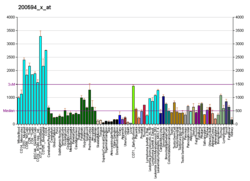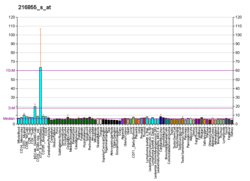HNRPU
Heterogeneous nuclear ribonucleoprotein U is a protein that in humans is encoded by the HNRNPU gene.[4][5]
Function
This gene belongs to the subfamily of ubiquitously expressed heterogeneous nuclear ribonucleoproteins (hnRNPs). The hnRNPs are RNA binding proteins that form complexes with heterogeneous nuclear RNA (hnRNA). These proteins are associated with pre-mRNAs in the nucleus and appear to influence pre-mRNA processing and other aspects of mRNA metabolism and transport. While all of the hnRNPs are present in the nucleus, some seem to shuttle between the nucleus and the cytoplasm. The hnRNP proteins have distinct nucleic acid binding properties. The protein encoded by this gene contains a RNA binding domain and scaffold-associated region (SAR)-specific bipartite DNA-binding domain. This protein is also thought to be involved in the packaging of hnRNA into large ribonucleoprotein complexes. During apoptosis, this protein is cleaved in a caspase-dependent way. Cleavage occurs at the SALD site, resulting in a loss of DNA-binding activity and a concomitant detachment of this protein from nuclear structural sites. But this cleavage does not affect the function of the encoded protein in RNA metabolism. At least two alternatively spliced transcript variants have been identified for this gene.[6]
Interactions
HNRPU has been shown to interact with:
References
- GRCh38: Ensembl release 89: ENSG00000153187 - Ensembl, May 2017
- "Human PubMed Reference:". National Center for Biotechnology Information, U.S. National Library of Medicine.
- "Mouse PubMed Reference:". National Center for Biotechnology Information, U.S. National Library of Medicine.
- Fackelmayer FO, Richter A (Mar 1994). "hnRNP-U/SAF-A is encoded by two differentially polyadenylated mRNAs in human cells". Biochim Biophys Acta. 1217 (2): 232–4. doi:10.1016/0167-4781(94)90044-2. PMID 7509195.
- Fackelmayer FO, Richter A (Sep 1994). "Purification of two isoforms of hnRNP-U and characterization of their nucleic acid binding activity". Biochemistry. 33 (34): 10416–22. doi:10.1021/bi00200a024. PMID 8068679.
- "Entrez Gene: HNRNPU heterogeneous nuclear ribonucleoprotein U (scaffold attachment factor A)".
- Martens JH, Verlaan M, Kalkhoven E, Dorsman JC, Zantema A (Apr 2002). "Scaffold/matrix attachment region elements interact with a p300-scaffold attachment factor A complex and are bound by acetylated nucleosomes". Mol. Cell. Biol. 22 (8): 2598–606. doi:10.1128/mcb.22.8.2598-2606.2002. PMC 133732. PMID 11909954.
- Kim MK, Nikodem VM (Oct 1999). "hnRNP U inhibits carboxy-terminal domain phosphorylation by TFIIH and represses RNA polymerase II elongation". Mol. Cell. Biol. 19 (10): 6833–44. doi:10.1128/MCB.19.10.6833. PMC 84680. PMID 10490622.
- Eggert M, Michel J, Schneider S, Bornfleth H, Baniahmad A, Fackelmayer FO, Schmidt S, Renkawitz R (Nov 1997). "The glucocorticoid receptor is associated with the RNA-binding nuclear matrix protein hnRNP U". J. Biol. Chem. 272 (45): 28471–8. doi:10.1074/jbc.272.45.28471. PMID 9353307.
- Taniura H, Yoshikawa K (2002). "Necdin interacts with the ribonucleoprotein hnRNP U in the nuclear matrix". J. Cell. Biochem. 84 (3): 545–55. doi:10.1002/jcb.10047. PMID 11813259.
Further reading
- Kiledjian M, Dreyfuss G (1992). "Primary structure and binding activity of the hnRNP U protein: binding RNA through RGG box". EMBO J. 11 (7): 2655–64. doi:10.1002/j.1460-2075.1992.tb05331.x. PMC 556741. PMID 1628625.
- Barel M, Balbo M, Gauffre A, Frade R (1995). "Binding sites of the Epstein-Barr virus and C3d receptor (CR2, CD21) for its three intracellular ligands, the p53 anti-oncoprotein, the p68 calcium binding protein and the nuclear p120 ribonucleoprotein". Mol. Immunol. 32 (6): 389–97. doi:10.1016/0161-5890(95)00005-Y. PMID 7753047.
- Sidorenko SP, Law CL, Chandran KA, Clark EA (1995). "Human spleen tyrosine kinase p72Syk associates with the Src-family kinase p53/56Lyn and a 120-kDa phosphoprotein". Proc. Natl. Acad. Sci. U.S.A. 92 (2): 359–63. doi:10.1073/pnas.92.2.359. PMC 42739. PMID 7831290.
- Jordan P, Heid H, Kinzel V, Kübler D (1995). "Major cell surface-located protein substrates of an ecto-protein kinase are homologs of known nuclear proteins". Biochemistry. 33 (49): 14696–706. doi:10.1021/bi00253a007. PMID 7993898.
- Liu Q, Dreyfuss G (1996). "A novel nuclear structure containing the survival of motor neurons protein". EMBO J. 15 (14): 3555–65. doi:10.1002/j.1460-2075.1996.tb00725.x. PMC 451956. PMID 8670859.
- Fujioka Y, Matozaki T, Noguchi T, Iwamatsu A, Yamao T, Takahashi N, Tsuda M, Takada T, Kasuga M (1997). "A novel membrane glycoprotein, SHPS-1, that binds the SH2-domain-containing protein tyrosine phosphatase SHP-2 in response to mitogens and cell adhesion". Mol. Cell. Biol. 16 (12): 6887–99. doi:10.1128/MCB.16.12.6887. PMC 231692. PMID 8943344.
- Dennehy KM, Broszeit R, Garnett D, Durrheim GA, Spruyt LL, Beyers AD (1997). "Thymocyte activation induces the association of phosphatidylinositol 3-kinase and pp120 with CD5". Eur. J. Immunol. 27 (3): 679–86. doi:10.1002/eji.1830270316. PMID 9079809.
- Malik KF, Jaffe H, Brady J, Young WS (1997). "The class III POU factor Brn-4 interacts with other class III POU factors and the heterogeneous nuclear ribonucleoprotein U." Brain Res. Mol. Brain Res. 45 (1): 99–107. doi:10.1016/S0169-328X(96)00238-0. PMID 9105675.
- Eggert M, Michel J, Schneider S, Bornfleth H, Baniahmad A, Fackelmayer FO, Schmidt S, Renkawitz R (1997). "The glucocorticoid receptor is associated with the RNA-binding nuclear matrix protein hnRNP U." J. Biol. Chem. 272 (45): 28471–8. doi:10.1074/jbc.272.45.28471. PMID 9353307.
- Göhring F, Schwab BL, Nicotera P, Leist M, Fackelmayer FO (1998). "The novel SAR-binding domain of scaffold attachment factor A (SAF-A) is a target in apoptotic nuclear breakdown". EMBO J. 16 (24): 7361–71. doi:10.1093/emboj/16.24.7361. PMC 1170336. PMID 9405365.
- Hahm B, Cho OH, Kim JE, Kim YK, Kim JH, Oh YL, Jang SK (1998). "Polypyrimidine tract-binding protein interacts with HnRNP L.". FEBS Lett. 425 (3): 401–6. doi:10.1016/S0014-5793(98)00269-5. PMID 9563502.
- Matsui M, Breau WC, Iwasaki S, Hagiwara S, Tamai Y, Mori C, Bloom ML, Jerry MB, Eddy EM, Taketo MM (1999). "Retrovirus integration site Mintb encoding the mouse homolog of hnRNP U.". J. Biochem. 125 (6): 1104–14. doi:10.1093/oxfordjournals.jbchem.a022392. PMID 10348913.
- Kim MK, Nikodem VM (2000). "hnRNP U inhibits carboxy-terminal domain phosphorylation by TFIIH and represses RNA polymerase II elongation". Mol. Cell. Biol. 19 (10): 6833–44. doi:10.1128/MCB.19.10.6833. PMC 84680. PMID 10490622.
- Kipp M, Schwab BL, Przybylski M, Nicotera P, Fackelmayer FO (2000). "Apoptotic cleavage of scaffold attachment factor A (SAF-A) by caspase-3 occurs at a noncanonical cleavage site". J. Biol. Chem. 275 (7): 5031–6. doi:10.1074/jbc.275.7.5031. PMID 10671544.
- Husi H, Ward MA, Choudhary JS, Blackstock WP, Grant SG (2000). "Proteomic analysis of NMDA receptor-adhesion protein signaling complexes". Nat. Neurosci. 3 (7): 661–9. doi:10.1038/76615. hdl:1842/742. PMID 10862698.
- Taniura H, Yoshikawa K (2002). "Necdin interacts with the ribonucleoprotein hnRNP U in the nuclear matrix". J. Cell. Biochem. 84 (3): 545–55. doi:10.1002/jcb.10047. PMID 11813259.
- Lee J, Bedford MT (2002). "PABP1 identified as an arginine methyltransferase substrate using high-density protein arrays". EMBO Rep. 3 (3): 268–73. doi:10.1093/embo-reports/kvf052. PMC 1084016. PMID 11850402.
- Davis M, Hatzubai A, Andersen JS, Ben-Shushan E, Fisher GZ, Yaron A, Bauskin A, Mercurio F, Mann M, Ben-Neriah Y (2002). "Pseudosubstrate regulation of the SCF(beta-TrCP) ubiquitin ligase by hnRNP-U". Genes Dev. 16 (4): 439–51. doi:10.1101/gad.218702. PMC 155337. PMID 11850407.




